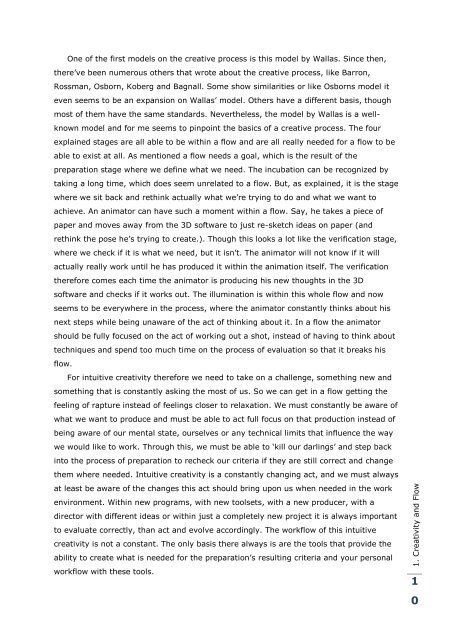Release. Pressure. Animate.
Release. Pressure. Animate.
Release. Pressure. Animate.
You also want an ePaper? Increase the reach of your titles
YUMPU automatically turns print PDFs into web optimized ePapers that Google loves.
One of the first models on the creative process is this model by Wallas. Since then,<br />
there‟ve been numerous others that wrote about the creative process, like Barron,<br />
Rossman, Osborn, Koberg and Bagnall. Some show similarities or like Osborns model it<br />
even seems to be an expansion on Wallas‟ model. Others have a different basis, though<br />
most of them have the same standards. Nevertheless, the model by Wallas is a well-<br />
known model and for me seems to pinpoint the basics of a creative process. The four<br />
explained stages are all able to be within a flow and are all really needed for a flow to be<br />
able to exist at all. As mentioned a flow needs a goal, which is the result of the<br />
preparation stage where we define what we need. The incubation can be recognized by<br />
taking a long time, which does seem unrelated to a flow. But, as explained, it is the stage<br />
where we sit back and rethink actually what we‟re trying to do and what we want to<br />
achieve. An animator can have such a moment within a flow. Say, he takes a piece of<br />
paper and moves away from the 3D software to just re-sketch ideas on paper (and<br />
rethink the pose he‟s trying to create.). Though this looks a lot like the verification stage,<br />
where we check if it is what we need, but it isn‟t. The animator will not know if it will<br />
actually really work until he has produced it within the animation itself. The verification<br />
therefore comes each time the animator is producing his new thoughts in the 3D<br />
software and checks if it works out. The illumination is within this whole flow and now<br />
seems to be everywhere in the process, where the animator constantly thinks about his<br />
next steps while being unaware of the act of thinking about it. In a flow the animator<br />
should be fully focused on the act of working out a shot, instead of having to think about<br />
techniques and spend too much time on the process of evaluation so that it breaks his<br />
flow.<br />
For intuitive creativity therefore we need to take on a challenge, something new and<br />
something that is constantly asking the most of us. So we can get in a flow getting the<br />
feeling of rapture instead of feelings closer to relaxation. We must constantly be aware of<br />
what we want to produce and must be able to act full focus on that production instead of<br />
being aware of our mental state, ourselves or any technical limits that influence the way<br />
we would like to work. Through this, we must be able to „kill our darlings‟ and step back<br />
into the process of preparation to recheck our criteria if they are still correct and change<br />
them where needed. Intuitive creativity is a constantly changing act, and we must always<br />
at least be aware of the changes this act should bring upon us when needed in the work<br />
environment. Within new programs, with new toolsets, with a new producer, with a<br />
director with different ideas or within just a completely new project it is always important<br />
to evaluate correctly, than act and evolve accordingly. The workflow of this intuitive<br />
creativity is not a constant. The only basis there always is are the tools that provide the<br />
ability to create what is needed for the preparation‟s resulting criteria and your personal<br />
workflow with these tools.<br />
1. Creativity and Flow<br />
1<br />
0


